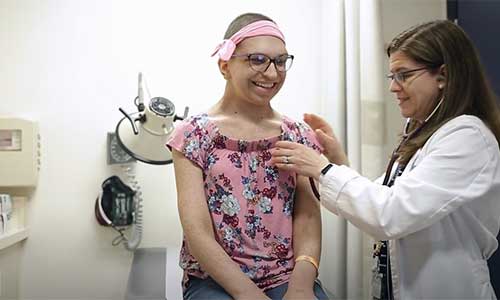Neurofibroma
What You Need to Know
- Neurofibromas can grow on nerves in the skin, under the skin or deeper in the body, including in the abdomen, chest and spine.
- Individual neurofibromas can grow sporadically. A genetic disorder such as neurofibromatosis (NF) can cause multiple neurofibromas.
- Most of these tumors do not hurt or cause problems, but some neurofibromas itch or are painful, and some become tumors.
- Treatment consists of observation and, if necessary, medications or surgical removal.
What is a neurofibroma?
Neurofibromas are benign (noncancerous) tumors that grow on nerves in the body. They consist of an overgrowth of nerve tissue along with blood vessels and other types of cells and fibers. Neurofibromas can grow on nerves in the skin (cutaneous neurofibroma), under the skin (subcutaneous neurofibroma) or deeper in the body, including in the abdomen, chest and spine.
What causes neurofibromas?
Most neurofibromas occur in association with a genetic disorder called neurofibromatosis type 1 (NF1). This condition can lead to multiple neurofibromas and other symptoms. A person with NF might have a few neurofibromas, or hundreds.
Solitary neurofibromas can also occur in people who don’t have NF. These are called sporadic neurofibromas. Their cause is not known, although researchers are exploring the role of trauma. Most sporadic neurofibromas don’t cause pain and can be managed without surgery or medication.
Types and Symptoms of Neurofibromas
Neurofibromas are classified based on where in the body they form and how deeply they are rooted. The symptoms vary depending on the tumor’s type, location and size.
- Cutaneous (dermal) neurofibromas are the most common type and are associated with NF1. They appear on or just under the skin as rubbery bumps or lumps, and can vary in size and number. Cutaneous neurofibromas may grow and multiply with age, but typically don’t cause significant symptoms other than possible itching and tenderness. Some, however, grow particularly large or in inconvenient places that cause cosmetic concerns and other issues.
- Diffuse neurofibromas also grow in the skin, but not just on the surface — they can penetrate deep into several layers of the skin and down to the base layer (fascia). They often appear as raised, soft to touch, tan-colored areas on the head, trunk and other parts of the body.
- Intramuscular neurofibromas grow on small nerves in the muscles. This type can cause pain.
- Spinal neurofibromas grow on the nerves exiting the spine. They are more common in adults than children, and if they grow large enough, spinal neurofibromas can compress nerves and cause pain, numbness or weakness.
Plexiform Neurofibromas
A plexiform neurofibroma (PN) can occur anywhere in the body. The name “plexiform” means they affect a nerve plexus — a network of large and small nerves that serve a specific part of the body. However, these rare tumors can also affect other tissue types, such as muscles and connective tissues.
- PNs growing in the skin (diffuse plexiform neurofibromas) can become large enough to cause the skin and underlying tissue to bulge, causing a deformity. These tumors can sometimes affect the head and the face.
- PNs that affect the large nerves exiting the spine, such as a sciatic nerve, are called nodular plexiform neurofibromas. Not always visible to the naked eye, on imaging scans they can appear as thickened areas on the nerve.
Plexiform neurofibromas are associated with NF1 and can be present at birth, although they can be hard to detect in a young person. Most do not cause any problems, but some plexiform neurofibromas can grow very large, place pressure on nerves and organs, and cause pain and weakness.
Even though they start out benign, plexiform neurofibromas can become cancerous and should be closely monitored by a physician.
Neurofibroma Diagnosis
Neurofibromas that affect the skin can be diagnosed during a physical examination. To confirm that they resulted from neurofibromatosis, your doctor may look for other symptoms or recommend more testing, including genetic testing.
Neurofibromas that form deeper in the body can be more difficult to diagnose. They can grow for a long time without causing symptoms, and they can resemble other tumors. Diagnostic tests for these neurofibromas may include magnetic resonance imaging (MRI), computerized tomography (CT) scan and electromyography (a study that measures electrical pathways in the nerves). A positron emission tomography (PET) scan or a biopsy may also be needed to confirm the diagnosis and examine the growth for cancerous changes.
Neurofibroma Treatment
Most neurofibromas don’t pose significant risks and can be monitored by a doctor with regular physical exams, imaging scans and, as needed, biopsy. If you’ve been diagnosed with neurofibromatosis, it’s best to discuss long-term management of your condition with an NF specialist.
Tell your doctor if:
- Neurofibromas change in color, size, texture or number, or if they become painful
- You develop new numbness or weakness in an area of the body
- Neurofibromas affect your quality of life by limiting movement, presenting cosmetic issues or growing in a location where they are bothersome or can be easily injured
Currently, there is no medication that can make most neurofibromas shrink or disappear, and once they grow, surgical removal is the only way to eliminate them. Selumetinib is an oral medication approved by the Food and Drug Administration for treatment of children with NF1 who are age 2 and older and who have plexiform neurofibromas that cause symptoms and can’t be removed surgically.
Chemotherapy and radiation therapy may be needed to address a malignant plexiform neurofibroma. Clinical trials may be available for certain types of neurofibroma.
Neurofibroma Surgery
Your doctor may recommend surgical removal of a neurofibroma that is causing pain or weakness, that is growing fast or that is suspected of developing into cancer.
Depending on the tumor’s location and size and its involvement with the underlying nerve, neurofibroma surgery can be complicated. There are several challenges your surgical team may need to address as it plans to remove the tumor. Your doctor will help you review the risks and benefits of surgery based on your unique symptoms and concerns.
Preserving Nerve Function
It can be difficult to separate the neurofibroma from the nerve, so it’s best to consult with surgeons who have expertise in peripheral nerve surgery. They can recommend the best surgical techniques for removing the tumor, partially or completely, while preserving nerve function. One such technique relies on using the operating microscope to carefully identify the components inside the nerve, and dissecting along tissue planes separating the neurofibroma from the healthy nerve tissues.
If the tumor is malignant, such as a malignant peripheral nerve sheath tumor (MPNST) or other sarcoma (a neurofibroma that became cancerous), it may be necessary to remove the portion of the nerve that contains cancer cells, as well as some normal tissue around it to prevent the tumor from coming back. A nerve graft repair may be performed to compensate for the removed nerve segment.
Control of Bleeding
Large neurofibromas, referred to as plexiform tumors, can be especially challenging to remove. They may have substantial blood supply and therefore may bleed extensively during surgery. In some cases, before a surgery to remove the tumor, your surgeon might recommend embolization — a procedure to cut off the neurofibroma’s blood supply. Depending on the tumor’s location, specialists in several fields may collaborate, working together as a surgical team to safely remove the tumor.
Preserving Appearance
Since neurofibromas may involve the skin, substantial portions of skin sometimes need to be removed with the tumor. This can have a major impact on your appearance, especially if the neurofibroma is in a prominent location such as the head or face. Plastic surgeons in a multidisciplinary center may use a variety of techniques, including skin flaps, skin grafts and skin expansion, to preserve your appearance after neurofibroma removal. The skin expansion method can be especially helpful after removal of facial or head tumors, because it may help prevent or reduce boldness by preserving the skin of the scalp.
NF Care at Johns Hopkins

The Johns Hopkins Comprehensive Neurofibromatosis Center is one of the few specialized centers in the world helping patients with NF1, NF2 and schwannomatosis. Our multi-specialty team uses the latest treatment approaches that aim to address all aspects of living with NF.




